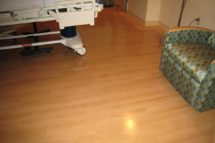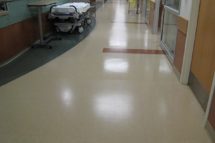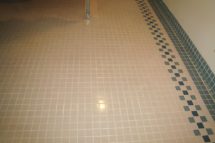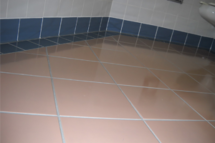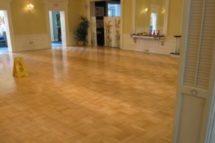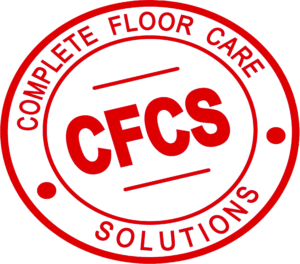Ceramic Tile

The use of ceramic tile can be traced back through history for more than 4000 years. That’s because man has always desired to produce living spaces that were beautiful, durable, and easy to maintain. Beautiful tile surfaces have been found in the oldest pyramids, the ruins of Babylon, and in the ruins of ancient Greek cities. Ceramic tile remains as popular as ever today as the floor of choice in public restrooms, schools, hospitals and numerous other applications. This ongoing popularity can be attributed to both the product’s durability and design versatility.
In terms of durability, the compressive strengths of ceramic materials are extremely high, normally 50,000 to 100,000 pounds per square inch. This hardness makes ceramic materials very resistant to abrasion. Ceramic tile is also resistant to almost all acids, alkalies, and organic solvents and has the ability to withstand extremely high temperatures.
It’s easy to understand how the popularity of ceramic tile itself has endured for more than 40 centuries. It’s the perfect sustainable building product. However, when you consider the use of ceramic tile in a commercial floor or wall application, you must give equal consideration to the selection of the grout that is used to bond the tile in place. Because it is the grout that eventually causes appearance problems and maintenance headaches. But what you see isn’t the worst part. The grout can also serve as a breeding ground for mold and mildew. In a locker room or around a pool deck, the problem can magnify. And more mopping will only tend to aggravate the situation. In severe situations, the grout can also cause the formations of airborne bacteria, which can cause serious health and sanitation issues.
To prevent a health or sanitation problem with tile floors, most businesses will hire a commercial tile cleaning company on a regular basis. This option can become costly, inconvenient and only clean the surface temporarily. The alternative to ongoing commercial tile cleaning is the SaniGLAZE restorative bonding or grout restoration process, which seals your tile floor and grout to keep contaminants out.
Grout
There are three basic types of grout: Cementitious, Modified and Epoxy. It’s important to understand the characteristics of each type before selecting a maintenance regiment or undertaking a replacement or restorative project.
- Cementitious grout, also known as Portland cement-based grout has been around since the 1820’s. It is by far the most popular type of grout used on ceramic tile floors and for a long time was the only available choice. The problem with this type of grout is its high porosity. Dirty mop water, urine, spilled soft drinks and other liquids are easily absorbed into the grout causing discoloration and a dark, dirty appearance.
- Modified grout is basically cementitious grout that has been enhanced with a polymer additive. There are a variety of these modified grouts on the market, but their acceptance in the marketplace has been guarded. The general consensus is that they make a ceramic tile floor more maintainable for a longer period of time, but, because the bond they create is still semi-porous, when they start to show discoloration, the problem is harder to remedy than it is with standard cementitious grout.
- Epoxy grout is the most recent addition to the maintenance arsenal. It is truly the only waterproof, non-porous type of grout currently available but it is also the most problematic. In a typical new commercial installation, epoxy grout is more expensive, slower to install because its quick set time means it can only be installed in small batches, and clean-up is more difficult and time consuming.
Restorative Bonding
Now that we have identified that the grout, not the ceramic tile itself, is the source of most maintainability problems; let’s look at possible solutions. A small percentage of design professionals in the market are dealing with new installations and the lesson here is simple: “Do it right the first time.”
The vast majority of you might be wrestling with issues in existing buildings, where you have only two choices – restore or replace. Replacement of ceramic tile wall or floor surfaces is a very costly and dirty job. In most cases, the building remains occupied and contractors are faced with the choice of shutting down entire floors or working only at night. Either way, it causes a great deal of inconvenience and, even under the most precautious conditions, the cement dust finds its way onto desktops, into computers and scores of other places
A popular cost effective and labor saving option is restorative bonding. Representing the latest advancements in polymer and sealant technology, restorative bonding provides a newly-installed look to any ceramic tile surface and, more importantly, creates a surface that is easily maintainable. In basic terms, restorative bonding is a three-step process that cleans tile and extracts contaminants form existing grout, bonds a non-porous polymer resin to the grout, and refinishes the entire surface with a protective shield to make the surface more attractive. The resin and shield prevent mold growth in the grout and the invasion of harmful contaminants.
Restorative bonding has been successfully used as an alternative to replacement in shopping centers, schools, municipal buildings, manufacturing plants, convention centers and other high-traffic commercial buildings. Cost savings have resulted from both the cost of restorative bonding in lieu of full replacement as well as in lower ongoing maintenance costs of commercial tile cleaning, experienced after the restoration. Although appearance and sanitation are significant issues, the most cost effective benefit of restorative bonding involves the ongoing maintenance. Whether it’s a new installation or a restoration, once the process is applied, the floor looks brand new and stays that way.
The SaniGLAZE® restorative bonding process is the solution to the headaches associated with maintaining your ceramic tile and grout through commercial tile cleaning.

